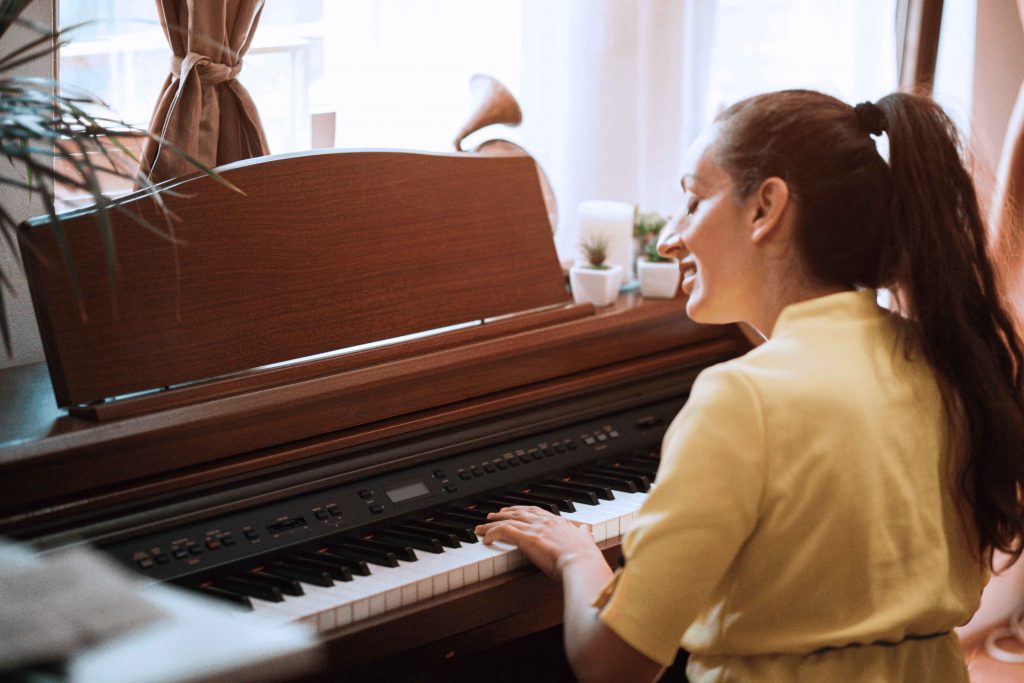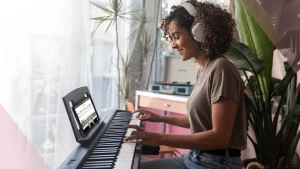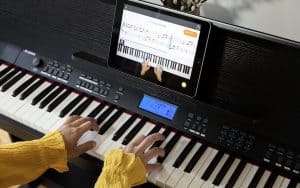Most people will identify as an auditory or visual learner. Occasionally, an individual is well balanced in both fields, but most people can relate to either learning primarily with their eyes or with their ears.
This is a fascinating world to extend to and explore with learning the piano. Practicing piano is pretty evenly split between the ears and eyes. However, auditory learners will approach learning piano, and music in general, much differently than visual learners. There are certain advantages and disadvantages present in visual learning vs auditory learning. In this article, we will explore the different ways that auditory and visual learners approach the piano and identify some commonalities that we all can learn from.

What big ears you have!
Auditory learners have a strong internal sense for music and can often imagine music in their minds, like a sort of auditory imagination. Often, they can break apart and identify key aspects of sound in piano music.
Many auditory learners can figure out melodies and chords on the piano just by using their ears. Sometimes, they can be less interested in the names of notes and chords and how all the theory works; they just simply know if the music they create matches the music they hear.
Auditory learners often find the most success when listening to other pianists perform or by learning from recordings or videos. However, sometimes auditory learners miss out on developing solid fundamental piano skills. Since they can naturally hear the music they want to learn, less thought might go into the fingering choices they make. While auditory learners may learn to play piano more quickly than visual learners, they run the risk of developing bad habits in their technique.
The challenges of auditory learning
Learning to read sheet music can be a challenge for auditory learners. Learning basic skills from a book might make an auditory learner feel that they are backtracking because they have probably already learned more difficult music by ear. Many beginning piano methods are more geared towards visual learners and are heavy on reading musical notation and symbols. While these are certainly extremely useful skills to develop as a pianist, an auditory learner might not place as much emphasis on these concepts.
Many beginner piano arrangements are simplified or transposed to easier keys. An auditory learner will have difficulty and potentially feel frustrated when trying to read these arrangements because they often do not sound exactly like the recording. They may feel like giving up on music. When an auditory learner tries to play one of these beginner piano arrangements with the original recording of a song, they will probably feel frustrated or confused why they spent all the time trying to read an arrangement when they could have simply learned the song by ear from the recording.
Despite these challenges, the ability to learn music by ear is a phenomenal skill that should be used to its fullest potential. Many auditory learners have an innate sense of musical expression and excel at excavating and conveying emotions from music since they often do not need to rely upon notated music.
Are you a visual learner?
Visual learners excel at memorizing visual patterns on the keyboard and often learn more quickly by reading musical notation and studying the concepts of piano music theory. Visual learners may feel baffled by how auditory learners can simply pick out melodies and chords seemingly out of thin air, but visual learners have their own set of strong skills as well.
Visual learners love to have musical notation to follow along with. This notation helps them tune in to the music and follow along with what is happening. They often move quickly through piano method books, since beginning methods are usually more geared towards memorizing visual and physical patterns on the keyboard.
Visual learners often take a more intellectual approach to learning the piano. They might not have the same level of intuitive skills with the piano as auditory learners, but their natural curiosity towards visual shapes and patterns allows them to engage with effort and discipline to crack the musical codes.
The challenge of visual learning
Visual learners might freeze up if asked to play something by ear or are thrown into an unfamiliar musical situation where they do not necessarily know what is happening. They might feel lost or lose confidence without some sheet music to help guide their way.
What can the auditory learn from the visual?
It is to the auditory learner’s advantage to study musical notation. Of course, learning to read music like a pro takes years and years of study, just like learning to read written words. Keeping this timeline in perspective will help auditory learners stay focused on the bigger picture.
While auditory learners excel at learning melodies and chords by ear, it is common for a few small details to escape them. By using sheet music, auditory learners can check their skills and fix any errors they might have picked up. For example, the way that a particular chord is voiced might be slightly different, a melody might have had a minor third instead of a major third, or a slightly different bass note might have been used. By checking ourselves with the sheet music, we are able to recognize these patterns more easily. This way, we can identify them right away the next time they come around!
Learning complex pieces from musical notation is helpful for auditory learners, but so is practicing sight reading. Practicing sight reading is different from learning a piece from music notation. When we practice sight reading, we find music that we have never played before and sit down to try and read it once or twice. Try practicing some sight reading with a relatively easy method book, there are many available.
What can the visual learn from the auditory?
Visual learners need to spend time actively listening to music. It is easy for a visual learner to become so enraptured with the notes on the page that they forget that they are attempting to make some music! Take time to actively listen for dynamics, expressive gestures, chord changes, mood changes, tempo and rhythm changes, and make some observations for yourself. Following along with your sheet music is also a great strategy.
Visual learners will also gain a great deal of skill from practicing ear training. A musician’s ears are like an athlete’s muscles. They must be trained and exercised in order to grow and develop. If you never practice hearing specific motives and gestures in music, you will lack a certain depth of understanding that comes from listening and comprehending what is happening in music. You will be able to identify intervals in music, scales, chords, keys, and much more.
Conclusion
As you progress down your path with piano, it is important to realize that being a visual or auditory learner is not a fixed position. Piano, and music in general, is both an auditory and visual phenomenon and it is crucial to your development to practice both skills. There are many magic piano hacks that all learners can benefit from.
If you are more of an auditory learner, it is to your advantage to double down on your reading practice. If you are more of a visual learner, take the time each day to listen intently to music and make observations about the changes and characters you hear. No matter which style you identify with most, Skoove is here to help you along your path to piano greatness!
Author of this blog post

Eddie Bond is a multi-instrumentalist performer, composer, and music instructor currently based in Seattle, Washington USA. He has performed extensively in the US, Canada, Argentina, and China, released over 40 albums, and has over a decade experience working with music students of all ages and ability levels.















